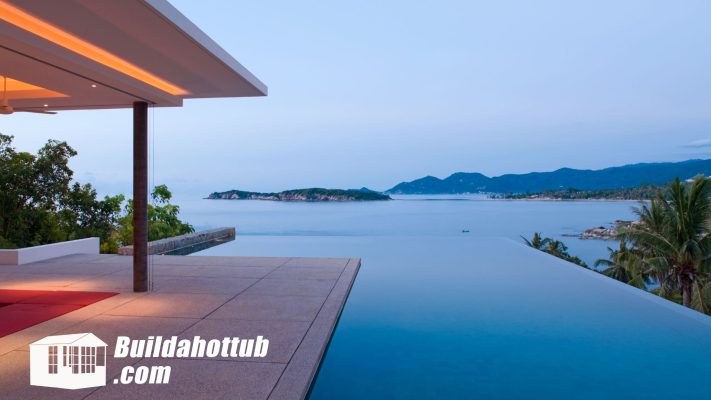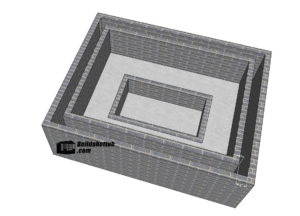Hey there, DIY hot tub enthusiast! Are you dreaming of a serene oasis right in your own backyard? Look no further than adding above ground hot tubs to your oasis – the perfect solution to unwind, rejuvenate, and create unforgettable moments of pure relaxation.
In this article, I, your trusty DIY Hot Tub design consultant, will guide you through the wondrous world of above ground hot tubs. Whether you’re a seasoned spa aficionado or a first-time soon to be hot tub builder, this blog post is packed with valuable information and helpful tips to help you make the most informed decisions.
Imagine soaking in warm, bubbling water under the open sky, surrounded by the soothing sounds of nature. Above ground hot tubs provide the ideal balance of convenience, affordability, and versatility, making them a popular choice for homeowners who crave the luxury of a spa experience without leaving their own home
So, if you’re ready to embark on a journey to transform your backyard into a personal paradise, join me as we dive into the world of above ground hot tubs. From the benefits they offer to the key considerations for selecting the perfect model, this article will equip you with the knowledge you need to create your very own hot tub haven.
Are you excited? I know I am! Let’s get started and discover how above ground hot tubs can elevate your relaxation game to new heights!
You can also find me on my socials;
Design Considerations for above ground hot tubs?
This is the fun part – you get to put your dream down on paper! When it comes to designing an above ground hot tub, several key considerations can greatly enhance your overall experience.
Let’s explore the important design factors, including location, size, shape, materials, and finishes.
Location: Choosing the right location for your above ground hot tub is crucial. Opt for an area that provides privacy and a pleasant view. Consider proximity to your home for convenience, but also assess factors like sun exposure, wind protection, and accessibility to electrical and plumbing connections. Remember, a well-planned location can significantly enhance the ambience and functionality of your hot tub space but also make the construction phase easier.
Size: The size of your hot tub should be determined by various factors, including the available space, the number of people you intend to accommodate, and your personal preferences. Larger tubs offer more room for socializing, while smaller ones are cozy for intimate soaks. Consider how often you entertain guests and strike a balance between size and your desired level of intimacy. There is nothing worse in my option of banging feet and legs with others in your tub – I like my space!
Shape: Above ground hot tubs come in various shapes, from traditional circles and squares to more contemporary designs like rectangles and ovals. The shape you choose should harmonize with your backyard aesthetic and complement the overall style of your outdoor space. Additionally, think about how the shape will affect the seating arrangement and ergonomics for a comfortable and enjoyable experience.
Materials and Finishes: Selecting high-quality materials and finishes is essential to ensure durability, longevity, and aesthetics. The finish tends to be one of the expensive bits and there are lots of options here – my recommendation is swimming pool tiles – I think they just look great even though they can be a little more expensive.
Swimming Pool Tiles Recommendation: For a touch of elegance and style, swimming pool tiles can be an excellent addition to your above ground hot tub. They not only enhance the visual appeal but also provide a smooth, slip-resistant surface. Consider using mosaic tiles that feature captivating designs and colors, creating a stunning focal point in your hot tub area. Choose tiles that are specifically designed for pool and spa environments, ensuring they are resistant to water, chemicals, and temperature variations.
Remember, selecting the right design elements for your above ground hot tub will contribute to the overall enjoyment and aesthetic appeal of your personal oasis. Take your time to evaluate your options, and create a space that reflects your unique style and enhances your relaxation experience. Happy designing!
What are the construction methods available for above ground hot tubs?
When it comes to constructing above ground hot tubs, there are several methods available, each with its own advantages. Let’s explore three common construction methods: CMU block, poured concrete forms, and ICF block.
However, it’s important to note that shotcrete and Gunite are not recommended for DIYers due to the specialized equipment and expertise required.
- CMU Block (Concrete Masonry Unit): Using CMU blocks involves stacking and mortaring concrete blocks to create the structure of the hot tub. This method offers several advantages. First, CMU blocks are readily available and relatively affordable. They provide a sturdy and durable foundation for the hot tub.
Additionally, CMU blocks can be easily customized, allowing you to create various shapes and sizes to suit your design preferences. The construction process is manageable for DIYers with basic masonry skills, making it a popular choice among those who enjoy hands-on projects.
- Poured Concrete Forms: Poured concrete forms involve building temporary wooden or metal forms to contain the concrete while it sets and cures. This method offers excellent flexibility in terms of shape and size customization. It allows for smooth, seamless surfaces without visible joints, providing a sleek and polished look.
Poured concrete forms provide a strong and long-lasting structure, and with proper reinforcement, they can withstand the weight and pressure of the hot tub. However, it’s worth noting that this method requires careful planning, accurate formwork, and proper concrete mixing and pouring techniques.
- ICF Block (Insulating Concrete Forms): ICF blocks (my favourite at the moment!) consist of foam panels that interlock and create a framework for concrete. This construction method offers superb insulation properties, which can help maintain the water temperature and reduce energy costs.
The foam panels also provide excellent soundproofing, resulting in a quieter hot tub experience. ICF block construction is relatively straightforward, making it suitable for DIYers. The lightweight foam panels are easy to handle, and the interlocking design simplifies assembly. Additionally, the insulating properties of ICF blocks contribute to energy efficiency and can enhance the overall sustainability of your hot tub.
Shotcrete and Gunite – Not a DIY Option
While shotcrete and Gunite are commonly used in professional construction, they require specialized equipment, such as a pneumatic spraying apparatus, and expert application techniques.
These methods are typically not recommended for DIYers due to the level of skill and knowledge required to achieve proper application and structural integrity.
When considering the construction method for your above ground hot tub, evaluate your DIY skills, budget, and desired features. It’s also advisable to consult with professionals or local building authorities to ensure compliance with safety codes and regulations.
Remember, the construction method you choose will play a significant role in the longevity and functionality of your hot tub, so choose wisely and enjoy the rewarding process of building your own relaxation haven.
What are the plumbing considerations for above ground hot tubs?
When it comes to plumbing considerations for above ground hot tubs, several factors should be taken into account to ensure optimal functionality and an enjoyable experience. Let’s delve into two important aspects: the location of the control room and the placement and configuration of jets.
- Location of the Control Room: The control room houses the equipment and plumbing components necessary for operating your hot tub, such as pumps, heaters, filters, and control panels. It is crucial to position the control room below the waterline of the hot tub. This is because the centrifugal pumps used in hot tubs rely on gravity to feed water to them. Placing the control room below the waterline ensures a natural flow of water, allowing the pumps to operate efficiently. Adequate access to the control room should also be considered for maintenance and repairs.
- Jet Considerations: Jets play a vital role in delivering the invigorating massage and hydrotherapy experience in a hot tub. When it comes to the number and placement of jets, it’s important to be mindful of certain limitations and user preferences.
- Number of Jets: The number of jets you can have in your hot tub is limited by the flow rate of the water pump(s). Generally, it is recommended to have no more than 16 jets per pump to ensure adequate water pressure and optimal performance. This limitation helps maintain a balance between water flow and pressure, ensuring an enjoyable massage experience for users.
- Jet Locations: The placement and configuration of jets can significantly alter the hydrotherapy experience in the hot tub. Some users prefer clusters of jets concentrated in specific areas, targeting specific muscle groups for a focused massage.
This arrangement allows for a more targeted and intense experience. On the other hand, having jets all in one line provides a broader, more evenly distributed massage experience, which may be preferred by those seeking a more gentle and relaxing soak.
Consider the preferences of your potential users and the type of hydrotherapy experience you wish to provide when determining the placement and configuration of jets in your above ground hot tub.
By carefully considering the location of the control room and the placement of jets, you can ensure optimal water flow, pressure, and an invigorating hydrotherapy experience for users of your above ground hot tub.
Conclusion
Congratulations! You have now journeyed through the captivating world of above ground hot tubs, exploring various design considerations and plumbing essentials. Armed with this newfound knowledge, you are well on your way to creating a backyard oasis that promises relaxation, rejuvenation, and countless blissful moments.
From selecting the perfect location, size, shape, materials, and finishes, to understanding the importance of the control room’s placement and the art of jet configuration, you now possess the insights necessary to embark on your hot tub project with confidence.
Remember, thoughtful planning and careful consideration of these factors will ensure that your above ground hot tub harmoniously blends into your outdoor space while offering a truly unforgettable experience.
Whether you envision a cozy retreat for intimate soaks or a vibrant social hub for entertaining friends and family, the design possibilities are endless. Let your creativity guide you as you transform your backyard into a personal sanctuary, perfectly tailored to your needs and preferences.
As a passionate DIY Hot Tub consultant, I encourage you to embrace this exciting adventure while keeping safety, local regulations, and guidance in mind. Reach out to experts if you require additional assistance along the way, ensuring a successful and stress-free hot tub installation.
Now, take a moment to envision yourself sinking into the warm, bubbling waters of your above ground hot tub, surrounded by the serene beauty of your backyard. The worries of the day melt away as you indulge in the therapeutic embrace of the jets, providing relief to tired muscles and revitalizing your mind and body.
So, my fellow hot tub enthusiast, it’s time to roll up your sleeves, unleash your creativity, and make your hot tub dreams a reality. Create memories, unwind, and bask in the luxurious delight of your very own above ground hot tub. Your personal oasis awaits!
Happy building and here’s to countless moments of pure relaxation and bliss!
Andi
Can I Help You?
If I can help you in any way I would love to hear from you. You can get in touch using the form below.
Thanks - Andi
 Hi, Andi here. I own Buildahottub.com and also write all of the articles and info pages on the site. Some years back now, I built my own hot tub but struggled to find the information I needed. So, once my tub was complete, I started this website to help others in their own pursuit of hot tub and plunge pools DIY building information.
Hi, Andi here. I own Buildahottub.com and also write all of the articles and info pages on the site. Some years back now, I built my own hot tub but struggled to find the information I needed. So, once my tub was complete, I started this website to help others in their own pursuit of hot tub and plunge pools DIY building information.
Fast forward to 2025, I've helped over 1400+ DIY customers just like you all over the world build hot tubs and pools. Have a good look around the site, there are lots of resources here. Please do get in touch if I can help you. - Cheers, Andi
















